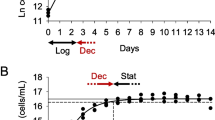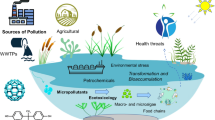Abstract
The cellular characteristics and antioxidant responses including reactive oxygen species (ROS), esterase activity, superoxide dismutase, peroxidase (POD), glutathione (GSH), and malondialdehyde (MDA) content of two microalgal species, Selenastrum capricornutum and Chlorella sp., exposed to single and mixed estradiol (E2) and ethinlyestradiol (EE2) at a final concentration of 200 μg L−1 were investigated. The growth, autofluorescence, cell complexity, and cell size of S. capricornutum and Chlorella sp. were not affected by single and mixed estrogen treatments, but the temporal trends of these two species were different. The temporal changes of the esterase activity and ROS level in these two species were also very different, with a continuous increase with time in Chlorella but peak on Day 2 in S. capricornutum. The esterase activity of S. capricornutum was not affected by estrogen treatments; however, the activity in treated Chlorella decreased significantly from Day 2 onwards. The single EE2 and mixed E2 and EE2 treatments induced more ROS of S. capricornutum than the single E2 treatment and control on Day 4, but no other difference was found between treatments and control of Chlorella on that day. The other oxidative damage responses of S. capricornutum were not affected by estrogen treatments, except MDA increased in EE2 treatment, on the other hand, POD and GSH of Chlorella increased in both single and mixed estrogen treatments on Day 4. These results suggested that microalgae species were tolerant to E2 and EE2, but some species-specific changes occurred to combat the oxidative stress posed by estrogens.





Similar content being viewed by others
References
Anderson ME (1985) Determination of glutathione and glutathione disulfide in biological samples. Method Enzymol 113:548–555
Babu TS, Tripuranthakam S, Greenberg BM (2005) Biochemical responses of the aquatic higher plant Lemna gibba to a mixture of copper and 1,2-dihydroxyanthraquinone: synergistic toxicity via reactive oxygen species. Environ Toxicol Chem 24:3030–3036
Bannister J, Bannister W, Rotilio G (1987) Aspects of the structure, function, and applications of superoxide dismutase. CRC Crit Rev Biochem 22:111–180
Bernanke J, Kőler HR (2009) The impact of environmental chemicals on wildlife vertebrates. Rev Environ Contam Toxicol 198:1–47
Blokhina O, Virolainen E, Fagerstedt KV (2003) Antioxidants, oxidative damage and oxygen deprivation stress: a review. Ann Bot 91:179–194
Caldwell DJ, Mastrocco F, Anderson PD, Länge R, Sumpter JP (2012) Predicted-no-effect concentrations for the steroid estrogens estrone, 17β-estradiol, estriol, and 17α-ethinylestradiol. Environ Toxicol Chem 31:1396–1406
Chiou TJ, Chu ST, Tzeng WF (2003) Protection of cells from menadione-induced apoptosis by inhibition of lipid peroxidation. Toxicol 191:77–88
Debenest T, Gagné F, Petit AN, Kohli M, Eullafroy P, Blaise C (2010) Monitoring of a flame retardant (tetrabromobisphenol A) toxicity on different microalgae assessed by flow cytometry. J Environ Monit 12:1918–1923
Devasagayam TP (1986) Lipid peroxidation in rat uterus. Biochim Biophys Acta 21:507–514
Dorsey J, Yentsch C, Mayo S, McKenna C (1989) Rapid analytical technique for the assessment of cell metabolic activity in marine microalgae. Cytometry 10:622–628
Fine DD, Breidenbach GP, Price TL, Hutchins SR (2003) Quantitation of estrogens in ground water and swine lagoon samples using solid-phase extraction, pentafluorobenzyl/trimethylsilyl derivatizations and gas chromatography-negative ion chemical ionization tandem mass spectrometry. J Chromatogr A 1017:167–185
Franklin DJ, Berges JA (2004) Mortality in cultures of the dinoflagellate Amphidinium carterae during culture senescence and darkness. Proc Roy Soc Lond B Biol Sci B 271:2099–2107
Franklin NM, Adams MS, Stauber JL, Lim RP (2001) Development of an improved rapid enzyme inhibition bioassay with marine and freshwater microalgae using flow cytometry. Arch Environ Contam Toxicol 40:469–480
Gala WR, Giesy JP (1990) Flow cytometric techniques to assess toxicity to algae. In: Landis WG, van der Schalie WH (eds) Aquatic toxicology and risk assessment, vol 13. American Society for Testing and Materials, Philadelphia, pp 237–246
Gao QT, Tam NFY (2010) Growth, photosynthesis and antioxidant responses of two microalgal species, Chlorella vulgaris and Selenastrum capricornutum, to nonylphenol stress. Chemosphere 82:346–354
Greca MD, Pinto G, Pistillo P, Pollio A, Previtera L, Temussi F (2008) Biotransformation of ethinylestradiol by microalgae. Chemosphere 70:2047–2053
Hemeda HM, Klein BP (1990) Effects of naturally-occurring antioxidants on peroxidase-activity of vegetable extracts. J Food Sci 55:184–185
Hong Y, Hu HY, Li FM (2008a) Physiological and biochemical effects of allelochemical ethyl 2-methyl acetoacetate (EMA) on cyanobacterium Microcystis aeruginosa. Ecotoxicol Environ Saf 71:527–534
Hong Y, Hu HY, Li FM (2008b) Growth and physiological responses of freshwater green alga Selenastrum capricornutum to allelochemical ethyl 2-methyl acetoacetate (EMA) under different initial algal densities. Pestic Biochem Phys 90:203–212
Hutchins SR, White MV, Hudson FM, Fine DD (2007) Analysis of lagoon samples from different concentrated animal feeding operations for estrogens and estrogen conjugates. Environ Sci Technol 41:738–744
Jamers A, Lenjou M, Deraedt P, Bockstaele VD, Blust R, Coen DW (2009) Flow cytometric analysis of the cadmium-exposed green alga Chlamydomonas reinhardtii (Chlorophyceae). Eur J Phycol 44:541–550
James DE (1978) Culturing algae. Carolina Biological Supply Company, Burlington
Lagadic L, Coutellec MA, Caquet T (2007) Endocrine disruption in aquatic pulmonate molluscs: few evidences, many challenges. Ecotoxicol 16:45–59
Lai KW, Scrimshaw MD, Lester JN (2002) Biotransformation and bioconcentration of steroid estrogens by Chlorella vulgaris. Appl Environ Microb 68:859–864
Lebel CP, Bondy SC (1990) Sensitive and rapid quantitation of oxygen reactive specie formation in rat synaptosomes. Neurochem Int 17:435–440
Lee MY, Shin HW (2003) Cadmium-induced changes in antioxidant enzymes from the marine alga Nannochloropsis oculata. J Appl Phycol 15:13–19
Lei AP, Hu ZL, Wong YS, Tam NFY (2006) Antioxidant responses of microalgal species to pyrene. J Appl Phycol 18:67–78
Lei AP, Hu ZL, Wong YS, Tam NFY (2007) Removal of fluoranthene and pyrene by different microalgal species. Bio Tech 98:273–280
Lei AP, Wong YS, Tam NFY (2003) Pyrene-induced changes of glutathione-S-transferase activities in different microalgal species. Chemosphere 50:293–301
Li M, Hu CW, Zhu Q, Chen L, Kong ZM, Liu ZL (2006) Copper and zinc induction of lipid peroxidation and effects on antioxidant enzyme activities in the microalga Pavlova viridis (Prymnesiophyceae). Chemosphere 62:565–572
Li R, Chen GZ, Tam NFY, Luan TG, Shin PKS, Cheung SG, Liu Y (2009) Toxicity of bisphenol A and its bioaccumulation and removal by a marine microalga Stephanodiscus hantzschii. Ecotoxicol Environ Saf 72:321–328
Liu Y, Guan YT, Gao QT, Tam NFY, Zhu WP (2010) Cellular responses, biodegradation and bioaccumulation of endocrine disrupting chemicals in marine diatom Navicula incerta. Chemosphere 80:592–599
Manly BFJ (1994) Multivariate statistical methods: a primer, 2nd edn. Chapman & Hall, London
Newsted JL (2004) Effect of light, temperature, and pH on the accumulation of phenol by Selenastrum capricornutum, a green alga. Ecotoxicol Environ Saf 59:237–243
Oyanagui Y (1984) Reevaluation of assay methods and establishment of kit for superoxide dismutase activity. Anal Biochem 142:290–296
Perron MC, Juneau P (2011) Effect of endocrine disrupters on photosystem II energy fluxes of green algae and cyanobacteria. Environ Res 111:520–529
Pintoa E, Van Nieuwerburgha L, de Barrosc MP (2003) Density-dependent patterns of thiamine and pigment production in the diatom Nitzschia microcephala. Phytochemistry 63:155–163
Pinto E, Sigaud-Kutner TCS, Leitao MAS, Okamoto OK, Morse D, Colepicolo P (2003) Heavy metal-induced oxidative stress in algae. J Phycol 39:1008–1018
Porte C, Janer G, Lorusso LC, Ortiz-Zarragoitia M, Cajaraville MP, Fossi MC, Canesi L (2006) Endocrine disruptors in marine organisms: approaches and perspectives. Comp Biochem Physiol 143:303–315
Racz L, Goel RK (2010) Fate and removal of estrogens in municipal wastewater. J Environ Moni 12:58–70
Rhee S, Chae H, Kim K (2005) Peroxiredoxins: a historical overview and speculative preview of novel mechanisms and emerging concepts in cell signaling. Free Radic Biol Med 38:1543–1552
Rioboo C, O’Connor JE, Prado R, Herrero C, Cid A (2009) Cell proliferation alterations in Chlorella cells under stress conditions. Aquat Toxicol 94:229–237
Sabatini SE, Juarez AB, Eppis MR, Bianchi L, Luquet CM, de Molina MDR (2009) Oxidative stress and antioxidant defenses in two green microalgae exposed to copper. Ecotoxicol Environ Saf 72:1200–1206
Scholz S, Klüver N (2009) Effects of endocrine disrupters on sexual, gonadal development in fish. Sex Dev 3:136–151
Shin HW, Sidharthan M, Young KS (2002) Forest fire ash impact on micro- and macro-algae in the receiving waters of the east coast of South Korea. Mar Pollut Bull 45:203–209
Song L, Liu Y (1999) FACHB-collection: freshwater algae culture collection of the institute Of Hydrobiology, list strain, 2nd edn. The Chinese Academy of Sciences, China, p 69
Soto P, Gaete H, Hidalgo ME (2011) Assessment of catalase activity, lipid peroxidation, chlorophyll-a, and growth rate in the freshwater green algae Pseudokirchneriella subcapitata exposed to copper and zinc. Lat Am J Aquat Res 39:280–285
Staples C, Mihaich E, Carbone J, Woodburn K, Klecka G (2004) A weight of evidence analysis of the chronic ecotoxicity of nonylphenol ethoxylates, nonylphenol ether carboxylates, and nonylphenol. Hum Ecol Risk Assess 10:999–1017
Tam NFY, Wong YS, Wong MH (2009) Novel technology in pollutant removal at source and bioremediation. Ocean Coast Manage 52:368–373
Yoshida K, Igarashi E, Mukai K, Hirata K, Miyamoto K (2003) Induction of tolerance to oxidative stress in the green alga, Chlamydomonas reinhardtii, by abscisic acid. Plant Cell Environ 26:451–457
Acknowledgments
The work described in this paper was supported by State Key Laboratory in Marine Pollution, City University of Hong Kong, and the Areas of Excellence Scheme established under the University Grants Committee of the Hong Kong SAR, China (project No. AoE/P-04/2004).
Author information
Authors and Affiliations
Corresponding author
Rights and permissions
About this article
Cite this article
Wang, P., Wong, M.H. & Tam, N.F.Y. Antioxidant responses of two microalgae, Selenastrum capricornutum and Chlorella sp., to estradiol and ethinylestradiol. J Appl Phycol 25, 891–903 (2013). https://doi.org/10.1007/s10811-012-9959-1
Received:
Revised:
Accepted:
Published:
Issue Date:
DOI: https://doi.org/10.1007/s10811-012-9959-1




